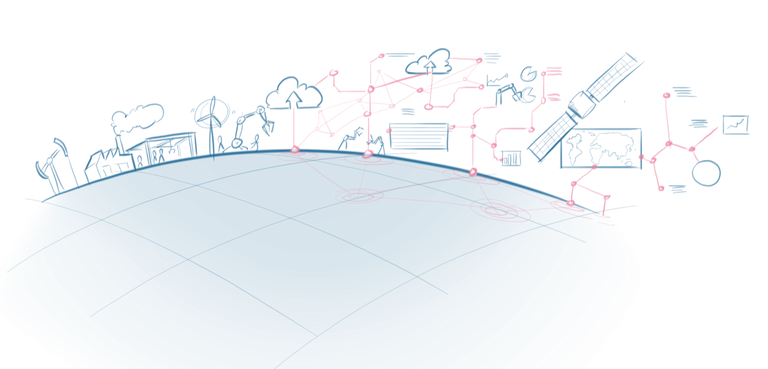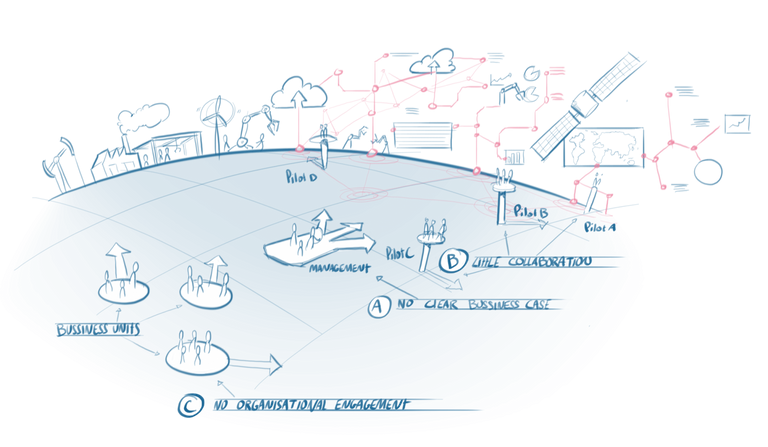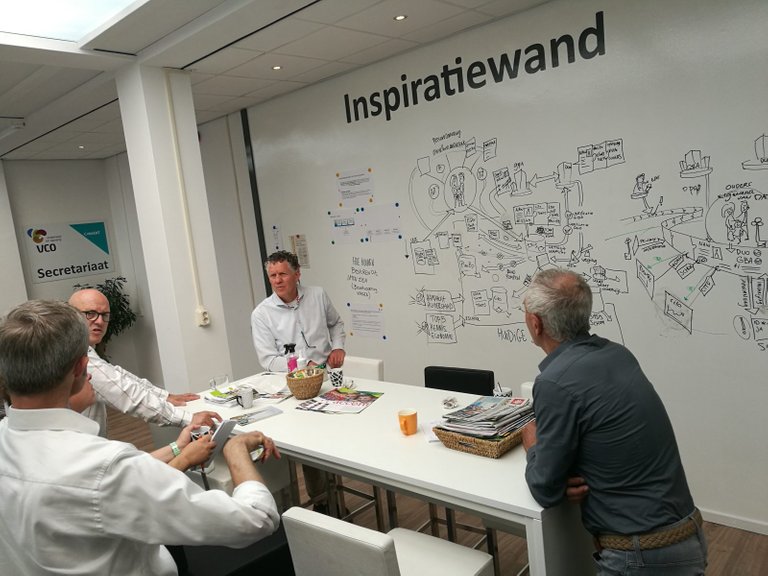The fourth industrial revolution
Creating a visual transformation hub in your organisation can catalyse the blockchain breakthrough you are looking for. Blockchain is a 2016 revelation that has continued to grow in 2017. The World Economic Forum named it as one of the biggest inventions since the birth of the internet. In fact, a survey of 500 CEO’s estimated that by 2025 10% of the global GDP will be on the blockchain. It is part of ‘The fourth industrial revolution’ where our world is becoming more and more digital. (World Economic Forum, June 2017)
Not going into too much technical detail; blockchain provides a way to transfer and maintain datasets in a very secured way and creates some digital scarcity. It started with financial transactions, the bitcoin, a scarce digital asset. During the development phase of this technology, we see more and more applications for business as well as for society.
Ink Strategy, through our focus on business strategy and innovation, sees the potential for blockchain. However, due to the complexity of the technology we see companies finding it hard to implement blockchain and therefore reap the benefits.

Strategic and organisational problems with blockchain?
So what are the biggest hurdles with blockchain? Our experience in different sessions with municipalities and organisations all across the Netherlands has shown three main issues that arise when discussing it.
A. If you have a hammer everything is a nail.
On executive boards there are always a couple of ‘blockchain believers’ who think it can solve all organisational problems and thus want to move everything on a blockchain.
But what is the real business case for blockchain? The technology is in its infancy; therefore there is no bench-marking and companies are still looking for business cases for the blockchain. The technology-driven approach doesn’t always comply with the existing business strategy, making it difficult to move from a concept to a proven business case.
B. A more digital and connected world means that silos have to be broken.
Digitalisation means increasingly working on an interwoven and transparent basis. Yet, we see companies trying to do it all by themselves, in their own silos which often means piloting on just a small part of a business process. Although trial and error is a good method for experiments, experiments with blockchain should be open; together with partners and stakeholders, not solely carried out by experts. There are numerous parties needed for a fully functioning blockchain.
C. The culture of an organisation can stand in the way.
What we have seen so far in our experience in companies working with blockchain is that it is 90% organisation and 50% technology. Due to the complexity of the technology, many people find it hard to grasp the concept. This creates a knowledge gap between the specialists/experts and the rest of the organisation. A lack of awareness and/or engagement hinders the innovation process.

Strategy, Collaboration and Engagement: How can we maximise the impact of blockchain in your business?
To tackle problem A (with a hammer, everything is a nail) we have to bring the technology to the boardroom. Opportunities for innovation lie where strategy and new technology meet. Blockchain is just an enabler, so focus on the overarching vision with the end customer in mind is crucial. Ask questions like how can blockchain benefit our customers? How can it increase collaboration? How can the blockchain help fix security issues? These kind of questions are a starting point to creating an impactful business model.
To remove silos (problem B), go out and find stakeholders; partners, customers and experts to work together. Even though piloting may go well, to fully grasp a complex technology like blockchain, you need to do it together. The fundamental principle of blockchain is decentralisation. We believe that the biggest value in this technology lies in the creation of a safe digital eco-system. Transparency and collaboration are key in this process.
Internal stakeholder engagement is a must to deal with problem C (culture). With emerging technologies people may see a threat to their relevance in the future. Organisations need all stakeholders to work together; to strive for the same vision and most importantly, to feel part of the change. Engaging, educating and collaborating are among the most important things to help your organisation evolve.
How a visual transformation hub can help to catalyse and implement your blockchain initiatives

A visual transformation hub means restructuring and clarifying the path and future of your company through visuals; Ink Strategy has worked with numerous companies to achieve this. We can facilitate a visual transformation hub that can catalyse technological breakthroughs in your organisation, addressing the three different problems.
A: To create an overarching vision we use design methods such as ‘future envisioning’, ‘customer journeys’ and ‘business modelling’ that lead to strong business cases for blockchain from a customer/business perspective rather than from a technological perspective.
B: Together with blockchain experts Franco de Vita and Robin Bertus from Blockchain Organiseren, Ink Strategy designs sessions to quickly move from the overarching vision to potential ‘proof of concepts. This is done in an open space where organisations collaborate. In our ongoing project with Dutch municipalities and another project with Dutch primary schools we see a lot of value in using blockchain to send private data to one another, preventing fragmentation of data.
C: We know the importance of engaging the whole organisation. Blockchain requires new mindsets and new ways of working, making it difficult to change stakeholders’ current ways of thinking. Visualisations unravel the complexity, combining emotion and thinking; making it a powerful tool to change mindsets.

To sum it all up
Creating a visual transformation hub can catalyse technological breakthroughs in your organisation. It creates an overarching vision that functions as a basis for innovation while stimulating collaboration and creative problem solving. Above all it creates awareness within your organisation, engaging employees and facilitating the embedding of the new technology.
Want to know more or create a visual transformation hub with Ink Strategy Ink Strategy? Contact us for more information and to start a dialogue about how we could work with your organisation.
Nice article and topic
Thanks Knowledges! Let me know if you have any feedback or want to hear more!